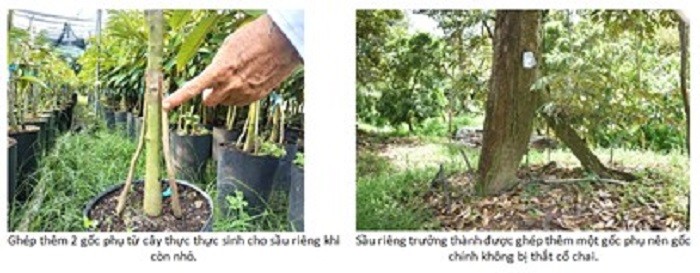No products in the cart.
NEWS
Rooted for Success: Unlocking the Power of Multi-Rootstock Grafting for Thriving Fruit Trees
As someone who has spent years nurturing plants and delving into the science of agriculture, I’ve seen many techniques that promise better yields and healthier crops. But few are as fundamentally impactful as leveraging the power of a robust root system. When it comes to fruit trees, especially those valuable and often temperamental varieties like durian, citrus, and jackfruit, the foundation is everything. This is where multi-rootstock grafting comes into play – a technique that doesn’t just support a tree, it empowers it.
Imagine a single tree drawing strength not just from one set of roots, but from several, each contributing its unique genetic advantages. That’s the essence of grafting multiple rootstocks onto a single scion (the upper fruiting part). Each rootstock is typically grown from a different seed, introducing genetic diversity that a single seedling root system simply can’t match. This inherent variability provides a multitude of benefits, making the resulting tree significantly more resilient and vigorous.
Why Multi-Rootstock Grafting Makes a Difference
The advantages of giving your fruit tree multiple root systems are profound and address some of the most common challenges growers face.
Enhanced Vigor and Nutrient Uptake
A single, robust root system is good, but multiple systems working in concert are exceptional. More roots mean a larger surface area actively exploring the soil. This dramatically improves the tree’s ability to absorb water and essential nutrients. The result? More vigorous growth, healthier foliage, and ultimately, better fruit production. It’s like giving your tree a supercharged engine.
Superior Disease Resistance
This is arguably one of the most critical benefits. Root diseases, like the dreaded Phytophthora that plagues many fruit trees, can be devastating. When a tree relies on just one root system, infection can quickly spread and be fatal. With multiple rootstocks, the situation changes entirely. If one root system succumbs to disease, the others can often continue to support the tree, providing precious time for intervention and recovery. The genetic diversity among the rootstocks also means some may inherently possess better resistance to specific pathogens.
- Expert Insight: According to veteran nursery owner and grafting specialist, Mr. David Chen, who has practiced this method for decades, “Observing trees with multiple rootstocks, especially durian in challenging environments, it’s clear they possess a resilience the single-grafted trees lack. When root issues arise, the redundancy provided by the extra root systems is a lifeline.”
Increased Stability and Wind Resistance
Fruit trees, particularly when laden with fruit, can be vulnerable to strong winds, especially in exposed or hilly areas. A common weak point can be the graft union itself, sometimes developing a “bottle neck” effect at the base. Trees grafted onto multiple rootstocks develop a broader, stronger, and more integrated base as the various rootstocks fuse with the main trunk over time. This composite structure provides significantly better anchoring, reducing the risk of breakage or uprooting during storms.
 Strong multi-rootstock grafted durian tree with a broad, stable base
Strong multi-rootstock grafted durian tree with a broad, stable base
Implementing the Technique
The technique involves grafting 2 to 3 (or even more) young rootstock seedlings around the base of the main scion or grafted seedling. These rootstocks are typically grafted using a proximity method, allowing them to fuse with the main stem as they grow. The number of rootstocks isn’t necessarily a case of ‘more is always better’; experts often recommend 2-3 as sufficient to provide significant benefits without overcomplicating the process or stressing the main plant too much initially.
While gaining popularity now, particularly with the boom in certain fruit crops like durian, this method isn’t entirely new. It’s a time-tested technique that draws on the fundamental principles of grafting and root system synergy. Its application extends well beyond durian and is beneficial for various grafted fruit trees including different citrus varieties (lemons, oranges, grapefruits), jackfruit, and more – essentially any fruit tree propagated by grafting.
Naturally, seedlings featuring this enhanced root system command a higher price than standard single-grafted trees, reflecting the extra effort and the significant long-term benefits they offer in terms of tree health, longevity, and productivity.
Conclusion
Building a successful orchard or even nurturing a single fruit tree in your garden starts from the ground up – specifically, with a healthy, vigorous root system. Multi-rootstock grafting is a powerful technique that provides trees with an unparalleled foundation, boosting their ability to absorb nutrients, resist disease, and stand strong against the elements. For growers looking to invest in the long-term health and productivity of their fruit trees, especially valuable or susceptible varieties, considering a multi-rootstock grafted seedling is a decision rooted in smart agricultural practice.
At Biogarden.asia, we believe in empowering growers with the best techniques and knowledge. While we offer a range of products to support plant health, understanding the fundamental advantages of choosing the right plant material, like multi-rootstock grafted trees where appropriate, is key to cultivating truly thriving plants. Have you experienced the benefits of multi-rootstock grafting? Share your stories!



